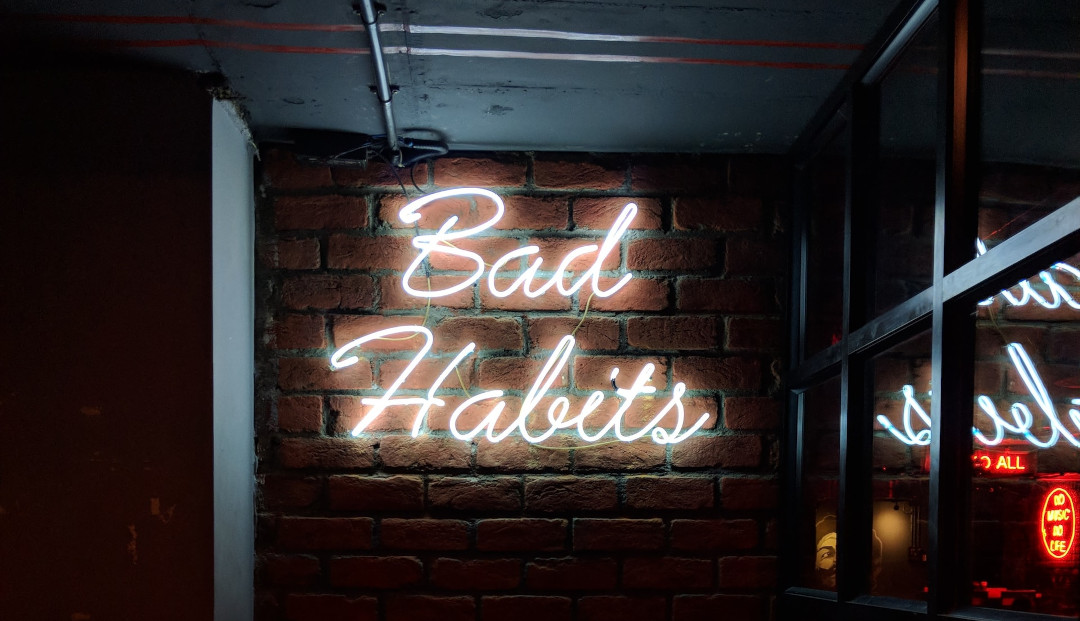How To Break A Bad Habit

Photo by Manan Chhabra
Four Approaches To Breaking A Bad Habit
There are four components to habits that you can leverage to break a bad habit. Namely:
- The trigger
- The craving
- The routine or behavior
- The reward
You can choose to attack your bad habit on any or all of these four components.
Let's go through an example.
Cookie Monster
Let's say you eat lots of cookies, particularly right after work, because you're tired and stressed and the sugar kick feels good, and the cookies next door to your job are delicious.
Here is your habit:
- Trigger(s): Work finishes, feeling tired and stressed, exiting work and looking next door at Acme's Cookies.
- Craving(s): The taste of those yummy, yummy cookies, and the sugar kick.
- Routine: Exit work, turn right, enter cookie shop, buy cookies, eat cookies.
- Reward(s): The texture and taste of the cookie, the energy of the sugar kicking in.
Now, if the trigger were less obvious, or the cravings were less attactive, or the routine were more difficult, or the rewards were less satisfying, then your bad habit wouldn't be so easy to maintain.
So, breaking a bad habit is about asking the following four questions, and testing out potential answers until you land on something that works well.
How might I make the trigger less obvious?
The the case of the cookie monster you might try to exit work from a back door, or work from home in the afternoons, or leave the building with a work friend.
You might eat an apple at work, before the tired feeling kicks in, or join a gym class that starts right when work ends. You might try to watch one silly video or scroll through a funny social media account as a way to destress before leaving work, or you might call a friend who's always cheerful on the way out as another way to destress.
There are always going to hundreds of ideas you can think of on how to make your bad habit triggers less obvious. The idea is to try them out, and continue doing what works well.
If something works well for a month, but then doesn't, no problem. First, celebrate that it worked for a month, then try to adapt the same technique, and if that doesn't work try out new ways to make the triggers less obvious.
How might I make the craving less attractive?
In the cookie monster example, you might try eating your lunch later, or having a healthy snack before leaving the office, sometimes a full glass of water can satiate a craving for a snack. You might set a reminder on your phone with a fitness goal you have right at the time work ends.
Again, there are hundreds of ideas on what you can do.
And, if something works for a while, great! Celebrate it. And if it stops working, adapt and improvise.
How might I make the routine more difficult?
The cookie monster routine was simply to walk downstairs, enter the cookie shop, take out the credit card, buy, and eat the cookies. Again, you can take a different exit out of the building, or you can put a credit card sized photo of a very large snake or spider or something else you are frightened of above your credit card in your wallet 🕷️
Anything you can do to make the routine harder, will increase the cost of engaging in the bad habit.
How might I make the reward less satisfying?
Finally, the reward.
For the cookie monster example, you can bring bitters with you, and add them on the cookies. Here you are literally training your tongue to think these cookies are nasty and bitter. You can soak the cookies in water and make them soggy ruining the texture. You can make a pact with your brother or cousin that every time you eat these cookies, you have to send him a video of you eating them that he will post on social media, or you have to send him $5.
There are innumerable ways. Get creative, try things out. See what works well for you.
Sources
James Clear, Atomic Habits
The Power Of Habit
